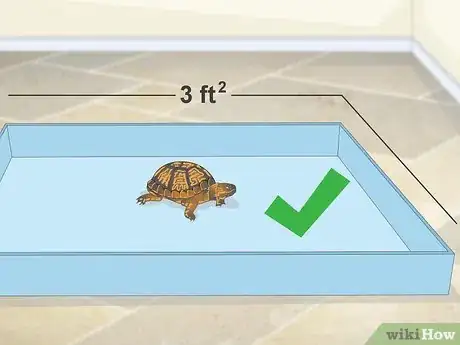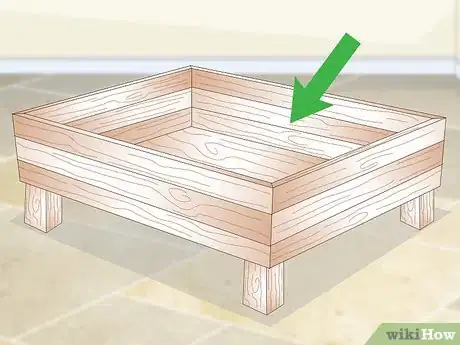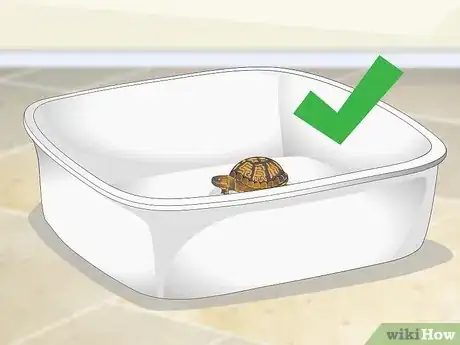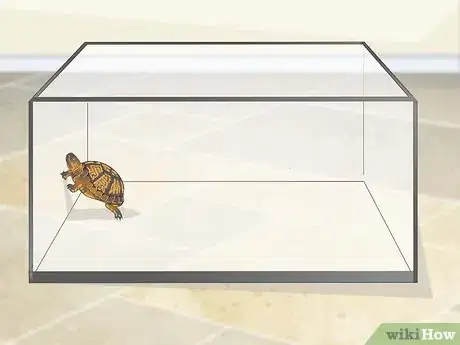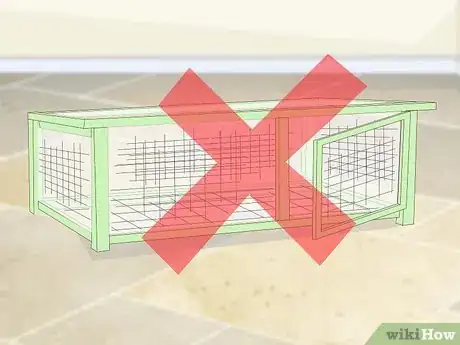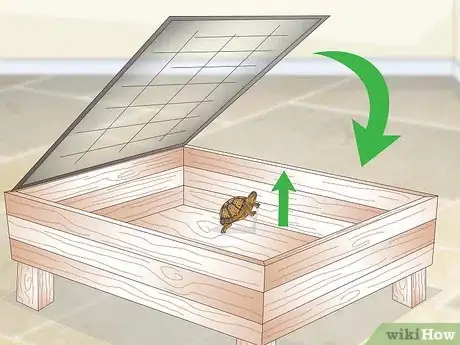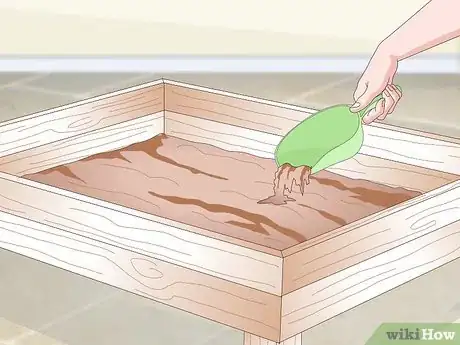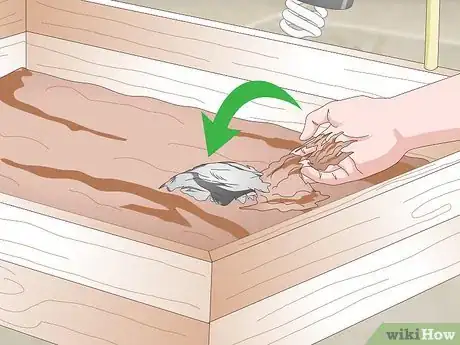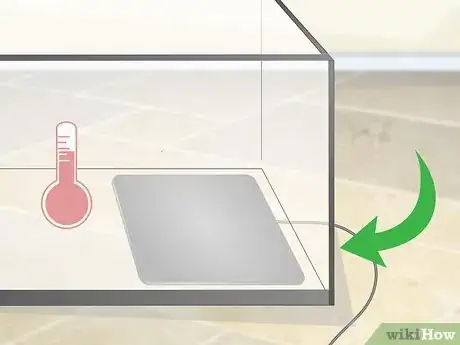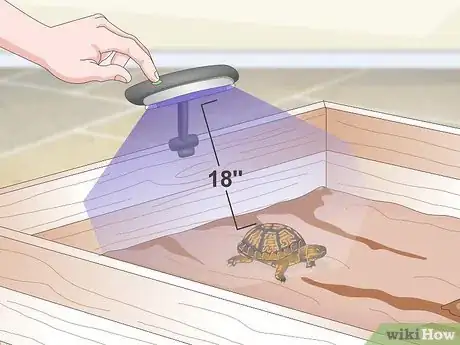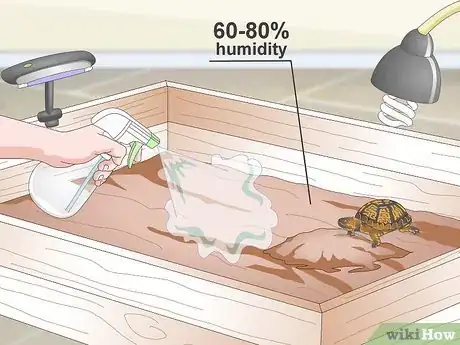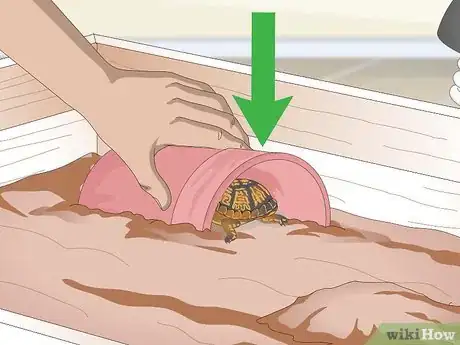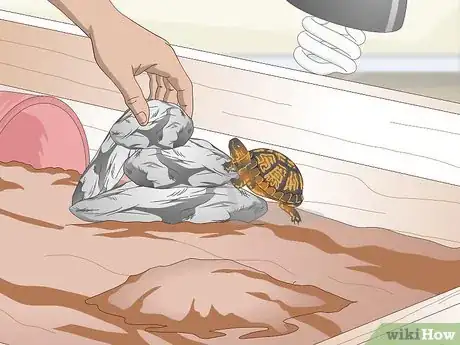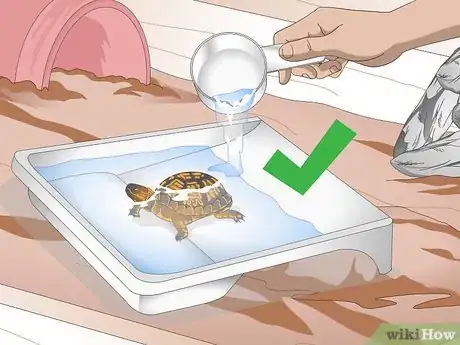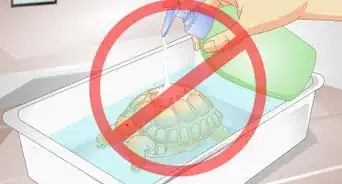This article was co-authored by Melissa Nelson, DVM, PhD. Dr. Nelson is a Veterinarian who specializes in Companion and Large Animal Medicine in Minnesota, where she has over 18 years of experience as a veterinarian in a rural clinic. She received her Doctor of Veterinary Medicine from the University of Minnesota in 1998.
wikiHow marks an article as reader-approved once it receives enough positive feedback. In this case, 95% of readers who voted found the article helpful, earning it our reader-approved status.
This article has been viewed 447,733 times.
Box turtles are best kept outdoors where they have a lot of roaming area. However, that doesn't mean that you can’t provide your box turtle with a great home if you live somewhere that can’t have an outdoor enclosure. Choosing a large enough enclosure, setting up proper heating elements, and providing the right accessories can give your box turtle a home they will love.
Steps
Choosing the Proper Housing
-
1Set up a large enough enclosure. Box turtles need a lot of room to roam like in the wild. Each turtle in your terrarium needs at least three square feet (0.28 m2) of floor space for every eight inches (20 cm) of their length. This provides them enough room to roam, dig, and explore.[1]
- For example, a 12 inch (30 cm) turtle needs at least a 4.5 sq ft (0.42 m2) of space. If you have two turtles of 12 inches, you need 9 sq ft (0.84 m2) of space.
-
2Try a turtle table. A turtle table is a shallow, rectangular wooden box. You can buy a turtle box from a commercial seller, or make your own. It just needs four sides and a floor. Make sure the sides are high enough so that the turtle can’t get out. Around 1.5 feet (0.5 m) (45 cm) should be tall enough.[2]
- If you build the enclosure from wood, waterproof the inside bottom and sides. Nontoxic paint or water sealant works well. This keeps the enclosure from absorbing water.
- Do not use treated wood, as it may harm the turtle.
Advertisement -
3Use a plastic container. You don’t have to buy an expensive turtle enclosure or build one. You can use a plastic wading pool or a plastic storage container to set up a habitat. These are cheap and easily replaceable. They also are large enough so that you can fit multiple turtles inside.[3]
- Wading pools are rather large, so you need a large amount of floor space for it.
-
4Consider a glass aquarium. Glass aquariums are not the best choice for box turtles because they are clear all the way around. However, if you want to place your turtle in an aquarium, just make sure you set it up correctly. Place cardboard or paper around three of the four glass walls to help give your turtle safety and security.[4]
- Turtles don’t like to be out in the open and constantly visible. It can cause them stress and they may hurt themselves.
-
5Avoid wire cages. Most cages that are designed for reptiles aren’t suitable for turtles. Never place turtles in a wire reptile cage because they can injure themselves on the wire. Plastic reptile cages may be okay for your turtle, but they may be too small. You need to make sure they will be big enough.[5]
-
6Create an enclosure that is escape-proof. Box turtles are notorious for escaping from their habitats. This means you should make sure to make your box turtle habitat as secure as possible. The sides should be completely vertical so the turtle can’t climb up the side. They should also be high enough that the turtle cannot climb over, generally twice as long as the turtle.[6]
- Place a cover on your habitat. You can use mesh screening or hardware cloth over the enclosure.
- Don’t place any objects along the sides or in the corner of the enclosure. This just makes it very easy for the turtle to climb out.
Setting Up the Habitat
-
1Add substrate. Substrate is the material that goes at the bottom of the cage. It helps hold moisture and gives the turtle plenty of opportunities to burrow. You can use peat-based potting soil mixed with orchid bark. You can also use fir bark, sphagnum moss, or pea gravel instead of orchid bark. These materials help retain humidity. Spread around two to three inches around the bottom of the entire enclosure.
- The potting soil should not contain additives like perlite, fertilizer, or Miracle-Gro.
- Avoid aquarium gravel or sand. They hold too much water, which can deteriorate your turtle’s shell.
-
2Provide a heat lamp. Turtles need outside heat sources to stay warm. They like to bask in the sun in the wild, so you should provide them with warming spots. Half of your enclosure should be warm while the other side should be cooler so your turtle can adjust their temperature.
- Place an incandescent lamp on a far end of the enclosure to create a warm side.
- This should be set up on a timer so the turtle gets 12 to 14 hours of heat each day.
-
3Test the temperature. You should test the temperature on the warm side of the terrarium to make sure it is the appropriate temperature. Place a thermometer under the heat source at approximately the place your turtle will bask under it. The temperature should be around 85 degrees.[7]
- Make sure the lamp doesn’t make any part of the enclosure too hot to touch. This can burn your turtle.
-
4Place a heat rock in the substrate. Another option for a heat source is a heat rock. These heaters are buried underneath the substrate and provide heat to your turtles on their bellies. Make sure you cover the rock with substrate to protect your turtle. They shouldn’t lie directly on the rock.[8]
-
5Try an undercage heater. If you have a glass aquarium, you can place an undercage heater so the turtle can get heat from underneath. The heater can be attached directly to the tank.[9]
- These types of heaters should never be used on plastic or wooden enclosures.
-
6Provide a UV source. Box turtles need UV light to survive indoors. If you can expose your turtle to unfiltered UV light via a patio or open window for at least an hour daily, that should be enough. Otherwise, purchase a UV lamp. The UV lamp needs to provide both UVA and UVB rays.[10]
- Place the UV light around 18 inches (45 cm) from the turtle.
- Pet stores sell lights that are a heat lamp and UV source in one, which can be convenient.
-
7Keep the proper humidity level. Box turtles need a humid environment to thrive. The enclosure should be between 60 to 80 percent humidity. To achieve this, use the proper substrate so it will hold moisture. You should also mist the turtles daily to keep humidity levels high.[11]
- If your box turtle starts burrowing constantly, you need to up the moisture because they are searching for it in the ground.
Providing Accessories
-
1Add shelters. Your turtles need a place to hide away where they can’t be seen. Otherwise, they get stressed out and can hurt themselves or get ill. You can provide anything for the turtle to hide in as long as your turtle can fit inside.[12]
- You can use a hollow log or commercial hiding area. Box turtles are easy to please, so a plastic tub, a tipped-over flower pot, or some other solid area that provides cover will suffice.
-
2Add climbing obstacles. Turtles love to climb and explore. They need things to stimulate them, challenge them, and provide entertainment. Add climbing obstacles around the enclosure, such as rocks and logs.[13]
- Use around an inch thick flat and quite wide rocks to make a climbing material for your turtle.
- If your turtle is tiny, it helps to use something that isn't too thick to ensure it is easy for climbing.
-
3Provide a swimming area. Box turtles need fresh water to drink and to soak in. They love to spend time in ponds, so you should place this kind of area in the enclosure. Choose a water container that the turtle can get its whole body inside, but not so deep that the turtle’s head will be covered. They need to be able to stick their head out of water.
- Box turtles don’t care what their swimming are looks like. You can get a bowl from a pet store, or use paint trays, storage tubs, flower pot dishes, shallow ceramic bowls, or any other shallow container that will hold water.
- It is best to use filtered water in their habitat. You can install a water filter in their pool to keep the water clean. If you don't have a filter, replace the water every two to three days.[14]
References
- ↑ http://www.dummies.com/pets/reptiles/making-an-indoor-home-for-a-terrestrial-turtle-or-small-tortoise/
- ↑ http://www.dummies.com/pets/reptiles/making-an-indoor-home-for-a-terrestrial-turtle-or-small-tortoise/
- ↑ http://www.turtlepuddle.org/american/boxcare.html
- ↑ http://www.boxturtles.com/box-turtle-care/
- ↑ http://www.dummies.com/pets/reptiles/making-an-indoor-home-for-a-terrestrial-turtle-or-small-tortoise/
- ↑ http://www.dummies.com/pets/reptiles/making-an-indoor-home-for-a-terrestrial-turtle-or-small-tortoise/
- ↑ http://www.dummies.com/pets/reptiles/making-an-indoor-home-for-a-terrestrial-turtle-or-small-tortoise/
- ↑ http://www.petmd.com/reptile/species/common-box-turtle
- ↑ http://www.dummies.com/pets/reptiles/making-an-indoor-home-for-a-terrestrial-turtle-or-small-tortoise/
About This Article
To create an indoor box turtle habitat, start by getting a container that's at least 3 square feet per every 8 inches long your turtle is. You can use a plastic container, a glass aquarium, or a turtle table, but avoid wire cages since they're not safe for turtles. Then, once you have a container, line the bottom with fir bark, sphagnum moss, or pea gravel, and fill the container with shelters, things to climb on, and a dish filled with water. You should also provide a heater and a UV light for your turtle. For more tips from our Veterinary co-author, like how to keep the container humid, read on!
